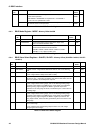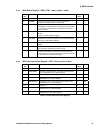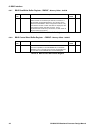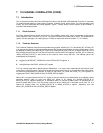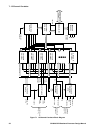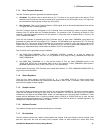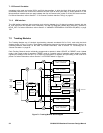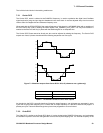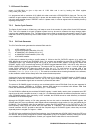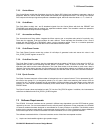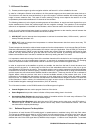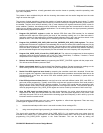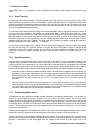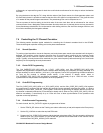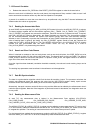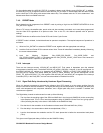7: 12-Channel Correlator
54 GP4020 GPS Baseband Processor Design Manual
output is 2.046 MHz, to give a chip rate of 1.023 MHz and is set by loading the 25-bit register
CHx_CODE_DCO_INCR.
It is programmed with a resolution of 85·14949 mHz when used with a GP2015/GP2010 front end. The very fine
resolution is again needed to keep the DCO in phase with the satellite signal. The Code DCO Phase can only be
set to the exact satellite phase in PRESET mode. In Update mode, it must be aligned with the satellite phase by
adjusting its frequency.
7.2.3 Carrier Cycle Counter
The Carrier Cycle Counter is 20-bits long, and keeps a count of the number of cycles of the Carrier DCO between
TICs. This is not needed for a basic navigation system but may be used to measure the range change (delta–
range) to each satellite between TICs. The delta ranges can be used to smooth the code pseudo–ranges. For finer
detail the Carrier DCO phase may also be read at each TIC to give the fractional part of the cycle count or delta–
range.
7.2.4 C/A Code Generator
The C/A Code Generator generates the selected Gold code for:
i) a GPS satellite (1 to 32),
ii) a ground transmitter (pseudolite, 33 to 37),
iii) an INMARSAT–GIC satellite (201 to 211),
iv) an INMARSAT-WAAS satellite (120 to 138)
v) a GLONASS satellite.
A Gold code is selected by writing a specific pattern of 10-bits to the CHx_SATCNTL register, or by setting the
GPS_NGLON bit to Low for the GLONASS code. Two outputs are generated to give both a PROMPT and a
TRACKING signal. The TRACKING signal can be set to one of four modes: EARLY (one half chip before the
PROMPT signal), LATE (one half chip behind), DITHERED (toggled between EARLY and LATE every 20ms) or
EARLY–MINUS–LATE (the signed difference). The output code is a sequence of +1’s and –1’s for all code types
except EARLY–MINUS–LATE where the result can also be a '0'. To avoid having an unused LSB in the
accumulators, the values in EARLY–MINUS–LATE mode are halved from the +2, 0, –2 that results from the
calculation (+1 or –1) – (+1 or –1) to +1, 0, –1. This must be considered when choosing thresholds in the software,
as the correlation results will be exactly half of the values otherwise expected.
At the end of every code sequence (1023 chips in GPS mode or 511 chips in GLONASS mode), a DUMP signal is
generated to latch the Accumulated Data for use by the signal tracking software. Each channel is latched
separately, as the satellite signals are not received in phase with each other.
The nature of GLONASS signals is that they are modulated with the same PRN Gold Code, but are separated in
the frequency domain (1597MHz to 1617MHz). Navstar GPS signals are modulated with different PRN Gold
Codes, but are transmitted on the same frequency (L1 = 1575.42MHz).
For the GP4020 to effectively de-modulate GLONASS signals, it would ideally need to have a separate set of RF
signal inputs for each correlator channel, in order for it to differentiate between the different frequencies used by
each GLONASS satellite. Since this facility is NOT available, the GP4020 cannot be used effectively to decode a
constellation of GLONASS signals.
Although the GP4020 contains a C/A code generator that can be used to demodulate GLONASS signals, the
GP4020 does NOT have a sufficiently wide Doppler-offset compensation range to allow it to be used effectively for
GLONASS. (The GLONASS code can be selected by setting the GPS_NGLON bit in CHx_SATCNTL to '0'). The
total frequency offset, which the carrier DCO can cope with, is ±2.857MHz. This means that the GP4020 12-
channel correlator will NOT be able to deal with the complete range of GLONASS signals, unless they are mixed
separately down to a digital IF of approx. 1.4MHz.
The GP1020, also available from Zarlink Semiconductor, has 10 separate sets of SIGN / MAG inputs from RF front-
end devices, which can be configured to connect independent to any of 6 correlator channels, making this device
more suitable for GLONASS applications. Contact your regional Zarlink sales office for more information.



